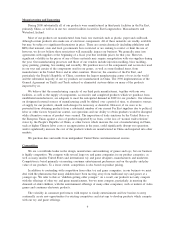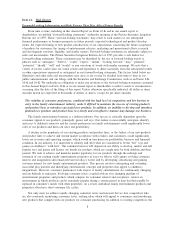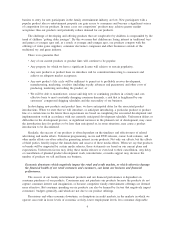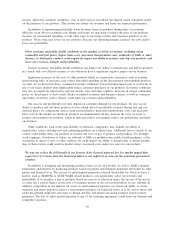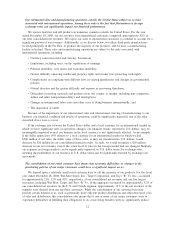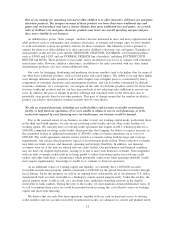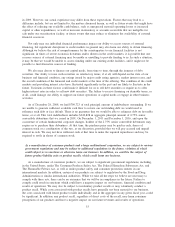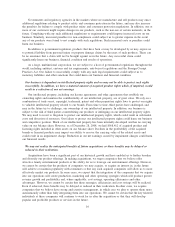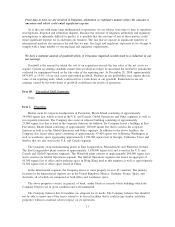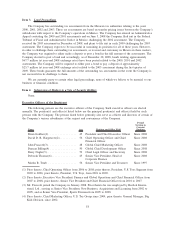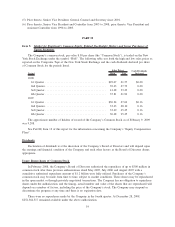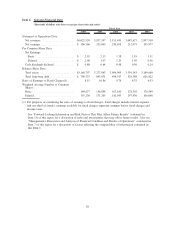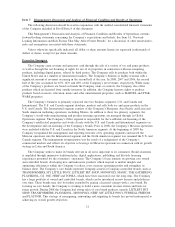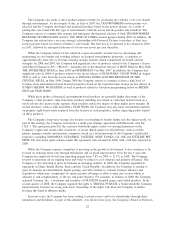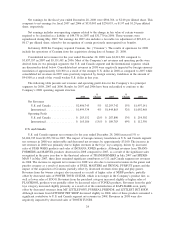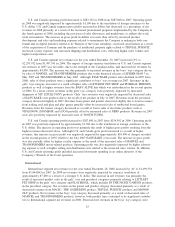Hasbro 2008 Annual Report Download - page 25
Download and view the complete annual report
Please find page 25 of the 2008 Hasbro annual report below. You can navigate through the pages in the report by either clicking on the pages listed below, or by using the keyword search tool below to find specific information within the annual report.in 2009. However, our actual experience may differ from these expectations. Factors that may lead to a
difference include, but are not limited to, the matters discussed herein, as well as future events that might have
the effect of reducing our available cash balance, such as unexpected material operating losses or increased
capital or other expenditures, as well as increases in inventory or accounts receivable that are ineligible for
sale under our securitization facility, or future events that may reduce or eliminate the availability of external
financial resources.
Not only may our individual financial performance impact our ability to access sources of external
financing, but significant disruptions to credit markets in general may also harm our ability to obtain financing.
Although we believe the risk of nonperformance by the counterparties to our financial facilities is not
significant, in times of severe economic downturn and/or distress in the credit markets, it is possible that one
or more sources of external financing may be unable or unwilling to provide funding to us. In such a situation,
it may be that we would be unable to access funding under our existing credit facilities, and it might not be
possible to find alternative sources of funding.
We also may choose to finance our capital needs, from time to time, through the issuance of debt
securities. Our ability to issue such securities on satisfactory terms, if at all, will depend on the state of our
business and financial condition, any ratings issued by major credit rating agencies, market interest rates, and
the overall condition of the financial and credit markets at the time of the offering. The condition of the credit
markets and prevailing interest rates have fluctuated significantly in the past and are likely to fluctuate in the
future. Variations in these factors could make it difficult for us to sell debt securities or require us to offer
higher interest rates in order to sell new debt securities. The failure to receive financing on desirable terms, or
at all, could damage our ability to support our future operations or capital needs or engage in other business
activities.
As of December 28, 2008, we had $709,723 of total principal amount of indebtedness outstanding. If we
are unable to generate sufficient available cash flow to service our outstanding debt we would need to
refinance such debt or face default. There is no guarantee that we would be able to refinance debt on favorable
terms, or at all. This total indebtedness includes $249,828 in aggregate principal amount of 2.75% senior
convertible debentures that we issued in 2001. On December 1, 2011 and December 1, 2016, and upon the
occurrence of certain fundamental corporate changes, holders of the 2.75% senior convertible debentures may
require us to purchase their debentures. At that time, the purchase price may be paid in cash, shares of
common stock or a combination of the two, at our discretion, provided that we will pay accrued and unpaid
interest in cash. We may not have sufficient cash at that time to make the required repurchases and may be
required to settle in shares of common stock.
As a manufacturer of consumer products and a large multinational corporation, we are subject to various
government regulations and may be subject to additional regulations in the future, violation of which
could subject us to sanctions or otherwise harm our business. In addition, we could be the subject of
future product liability suits or product recalls, which could harm our business.
As a manufacturer of consumer products, we are subject to significant government regulations, including,
in the United States, under The Consumer Products Safety Act, The Federal Hazardous Substances Act, and
The Flammable Fabrics Act, as well as under product safety and consumer protection statutes in our
international markets. In addition, certain of our products are subject to regulation by the Food and Drug
Administration or similar international authorities. While we take all the steps we believe are necessary to
comply with these acts, there can be no assurance that we will be in compliance in the future. Failure to
comply could result in sanctions which could have a negative impact on our business, financial condition and
results of operations. We may also be subject to involuntary product recalls or may voluntarily conduct a
product recall. While costs associated with product recalls have generally not been material to our business,
the costs associated with future product recalls individually and in the aggregate in any given fiscal year, could
be significant. In addition, any product recall, regardless of direct costs of the recall, may harm consumer
perceptions of our products and have a negative impact on our future revenues and results of operations.
15



